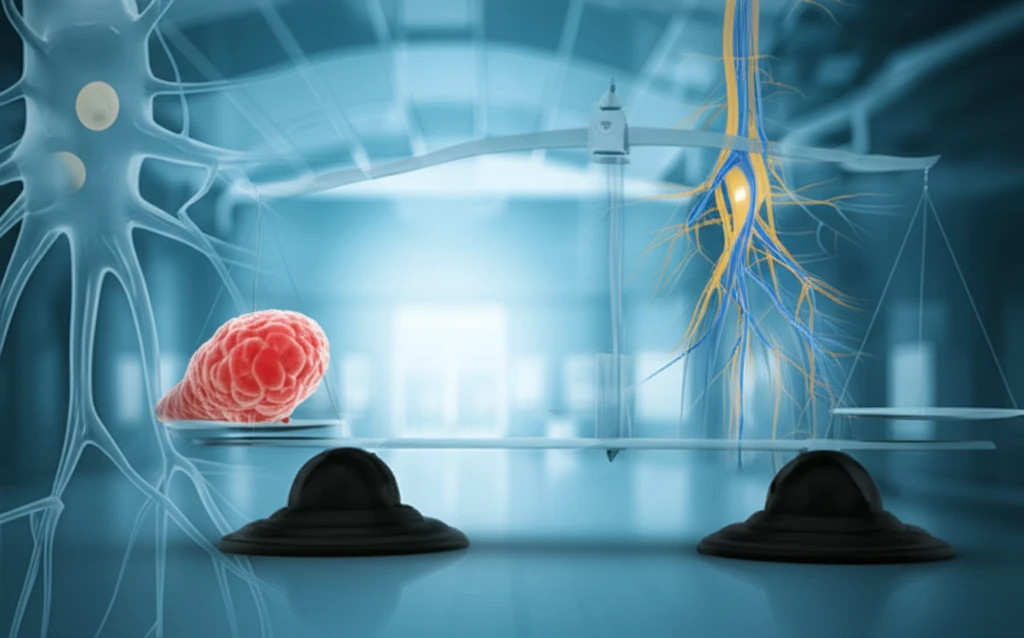
Preserving Hope and Function: Nerve and Vein Preservation in Oral Cancer Surgery
"A comprehensive look at how modern surgical techniques balance cancer treatment with quality of life."
Oral cancer, a significant subset of head and neck cancers, often necessitates complex surgical interventions. Historically, radical neck dissections, while effective in removing cancerous tissue, could lead to significant functional impairments due to the sacrifice of nerves and blood vessels. Modern surgical oncology has increasingly focused on function-preserving techniques, aiming to minimize these side effects without compromising oncological outcomes.
Among these techniques, modified radical neck dissections (MND), particularly Type II, have gained popularity. MND Type II involves preserving the spinal accessory nerve (SAN) and the internal jugular vein (IJV), structures crucial for shoulder function and venous drainage of the brain, respectively. The rationale is clear: maintaining these structures can lead to better postoperative quality of life. However, the critical question remains: How effective are these nerve and vein-sparing techniques in the long run?
A recent study published in Acta Otorhinolaryngologica Italica sought to answer this question by prospectively evaluating patients undergoing nerve and vein-sparing neck dissections for oral cancers. The study meticulously assessed spinal accessory nerve function and internal jugular vein patency following treatment, providing valuable insights into the delicate balance between cancer control and functional preservation. Understanding the outcomes of such studies is vital for patients, their families, and healthcare professionals alike, ensuring informed decisions about treatment strategies.
What Does Nerve and Vein Preservation Actually Mean for Patients?

The primary goal of nerve and vein preservation during oral cancer surgery is to reduce long-term complications. When the spinal accessory nerve is preserved, patients are more likely to maintain good shoulder function, avoiding the pain and limited mobility that can result from nerve damage. Similarly, preserving the internal jugular vein helps ensure proper blood flow, reducing the risk of swelling, headaches, and other circulatory issues.
- Nerve Dysfunction: There was a statistically significant increase in the latency (delay) of motor action potentials and a decrease in the amplitude (strength) of these potentials after surgery. This suggests that even with nerve preservation, some degree of nerve dysfunction is common.
- Vein Patency: Post-surgery, there was a significant decrease in the diameter of the internal jugular vein, accompanied by an increase in blood flow velocity. While most patients maintained adequate vein patency, a small percentage (5%) experienced partial thrombus formation.
- Functional Impact: Despite nerve dysfunction, shoulder abduction (raising the arm) was only moderately affected. The quality of life assessment showed a slight decrease in overall satisfaction, but this did not always translate into significant clinical impact.
Balancing Act: Weighing the Benefits and Risks
The decision to pursue nerve and vein-sparing techniques in oral cancer surgery is a complex one, requiring careful consideration of individual patient factors, tumor characteristics, and the surgeon's expertise. While these techniques offer the potential for improved quality of life, they must never compromise the primary goal of cancer control. Ongoing research and technological advancements continue to refine these procedures, striving for the optimal balance between oncological efficacy and functional preservation. If you or a loved one are facing oral cancer surgery, discuss these options thoroughly with your healthcare team to make informed decisions that align with your values and priorities.
